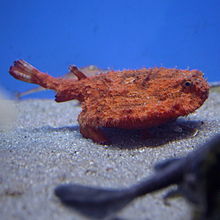
Goosefishes, sometimes called anglers or monkfishes, are a family, the Lophiidae, of marine ray-finned fishes belonging to the order Lophiiformes, the anglerfishes. These fishes are found in all the world's oceans except for the Antarctic Ocean.

The sea toads and coffinfishes are a family, the Chaunacidae, of deep-sea ray-finned fishes belonging to the monotypic suborder Chaunacoidei within the orderLophiiformes, the anglerfishes. These are bottom-dwelling fishes found on the continental slopes of the Atlantic, Indian, and Pacific Oceans, at depths to at least 2,460 m (8,070 ft). There have also been findings of deep-sea anglerfishes off the coasts of Australia and New Caledonia. Other findings suggest some genera of Chaunacidae are found near volcanic slopes encrusted with manganese. Of the two genera in the family, Chaunacops are typically found at deeper depths than Chaunax, but with considerable overlap between the two genera.

The spotfin frogfish, also known as the big-spot angler, coin-bearing frogfish, darkspot frogfish, ocellated angler, ocellated fringed fishing frog, opulent frogfish, spotfin angler or white-finger anglerfish, is a species ray-finned fish belonging to the family Antennariidae, the frogfishes. The spotfin frogfish is found in scattered locations the eastern Atlantic, Indian and western Pacific Oceans.
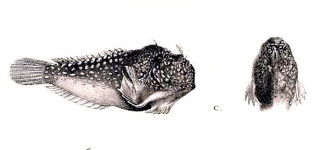
Tetrabrachiidae, or the four-armed frogfishes or doublefin frogfishes, is a small family of marine ray-finned fishes belonging to the suborder Antennarioidei in the order Lophiiformes, the anglerfishes. These fishes are found in relatively shallow waters of the eastern Indian Ocean and western Pacific Ocean.

The anglerfish are fish of the teleost order Lophiiformes. They are bony fish named for their characteristic mode of predation, in which a modified luminescent fin ray acts as a lure for other fish. The luminescence comes from symbiotic bacteria, which are thought to be acquired from seawater, that dwell in and around the sea.

Chaunax, variously known as coffinfishes, gapers or frogmouths, is a genus of marine ray-finned fishes, it is one of two genera belonging to the family Chaunacidae, the sea toads. They are found in tropical and subtropical oceans around the world typically in deep water.
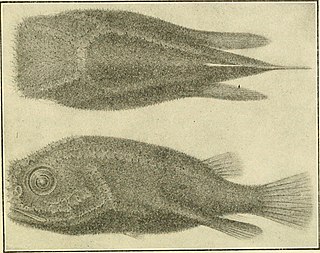
Coelophrys is a genus of marine ray-finned fishes belonging to the family Ogcocephalidae, the deep-sea batfishes or sea bats. The fishes in this genus are found in the western Pacific Ocean and the Indian Ocean.

Dibranchus is a genus of marine ray-finned fishes belonging to the family Ogcocephalidae, the deep sea batfishes. The fishes in this genus are widely distributed in the Atlantic, Indian and Pacific Oceans.

Antennarius is a genus of anglerfish belonging to the family Antennariidae, the frogfishes. The fishes in this genus are found in warmer parts of the Atlantic, Indian and Pacific Oceans.

Antennatus is a genus of marine ray-finned fishes belonging to the family Antennariidae, the frogfishes. The fishes in this genus are found the Indian and Pacific Oceans.
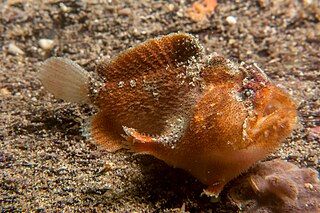
Echinophryne is a genus of marine ray-finned fishes belonging to the subfamily Histiophryninae in the family Antennariidae, the frogfishes. The fishes in this genus are endemic to the waters off Australia.
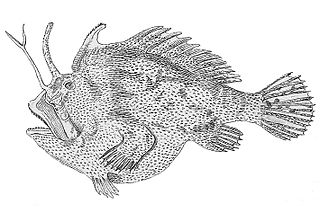
Kuiterichthys is a genus of marine ray-finned fishes belonging to the subfamily Histiophryninae in the family Antennariidae, the frogfishes. These fishes are endemic to Australia.
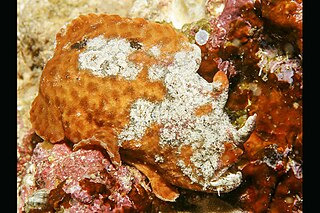
Phyllophryne is a monospecific genus of marine ray-finned fish belonging to the subfamily Histiophryninae in the family Antennariidae, the frogfishes. The only species in the genus is Phyllophryne scortea, the white-spotted anglerfish, smooth anglerfish or smooth frogfish, which is endemic to southern Australia.

Rhycherus is a genus of marine ray-finned fishes belonging to the subfamily Histiophryninae in the family Antennariidae, the frogfishes. The fishes in this genus are endemic to the waters off Australia. This genus is classified in the monogeneric family Rhycheridae, the Balrog frogfishes, by some authorities.

Lophiodes is a genus of marine ray-finned fishes belonging to the family Lophiidae, the goosefishes, monkfishes and anglers. It is one of four extant genera in the family Lophiidae. The fish in this genus are found in the Atlantic, Indian and Pacific Oceans.
Porophryne is a monospecific genus of marine ray-finned fish belonging to the subfamily Histiophryninae in the family Antennariidae, the frogfishes. The only species in the genus is Porophryne erythrodactylus, the red-fingered anglerfish, red-footed frogfish, Bare Island anglerfish or Sydney anglerfish, which is endemism to the waters off New South Wales in eastern Australia. Both the species and the genus were first described in 2014.

Lophiocharon trisignatus, the spot-tail anglerfish, rough anglerfish or three-spot frogfish, is a species of marine ray-finned fish belonging to the subfamily Histiophryninae in the family Antennariidae, the frogfishes. This fish is found in the Indo-Pacific region.

Antennarioidei is a suborder of marine ray-finned fishes belonging to the order Lophiiformes, the anglerfishes.

Histiophryninae, the star-fingered frogfishes, is a subfamily of marine ray-finned fishes belonging to the family Antennariidae, the frogfishes. The species in this family are found in the Indian and Western Pacific Oceans.

Ceratioidei, the deep-sea anglerfishes or pelagic angletfishes, is a suborder of marine ray-finned fishes, one of four suborders in the order Lophiiformes, the anglerfishes. These fishes are found in tropical and temperate seas throughout the world. One of the better known traits of the deep-sea anglerfishes is their extreme sexual dimorphism where the males are many times smaller than the females, the males seek out females and use their sharp teeth to clamp onto the females where he remains for the rest of his life, in some species he becomes part of the female. This is the only known natural example of a process called parabiosis. Another common trait of deep-sea anglerfishes is that they use bioluminescence on their esca to attract prey in the darkness of the deep oceans they inhabit.
